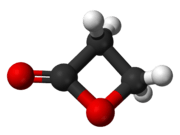beta-Propiolactone
 | |
 | |
| Names | |
|---|---|
| IUPAC names
Oxetan-2-one 3-Hydroxypropanoic acid lactone | |
| Other names
Propiolactone β-Propiolactone 2-Oxetanone | |
| Identifiers | |
| 57-57-8 | |
| 3D model (Jmol) | Interactive image |
| ChEBI | CHEBI:49073 |
| ChEMBL | ChEMBL1200627 |
| ChemSpider | 2275 |
| ECHA InfoCard | 100.000.309 |
| EC Number | 200-340-1 |
| KEGG | D05630 |
| UNII | 6RC3ZT4HB0 |
| |
| |
| Properties | |
| C3H4O2 | |
| Molar mass | 72.06 g·mol−1 |
| Appearance | Colorless liquid |
| Odor | slightly sweet[1] |
| Density | 1.1460 g/cm3 |
| Melting point | −33.4 °C (−28.1 °F; 239.8 K) |
| Boiling point | 162 °C (324 °F; 435 K) (decomposes) |
| 37 g/100 mL | |
| Solubility in organic solvents | Miscible |
| Vapor pressure | 3 mmHg (25°C)[1] |
| Refractive index (nD) |
1.4131 |
| Hazards | |
| Flash point | 74 °C; 165 °F; 347 K [1] |
| Explosive limits | 2.9%-?[1] |
| US health exposure limits (NIOSH): | |
| PEL (Permissible) |
OSHA-Regulated carcinogen[1] |
| REL (Recommended) |
Ca[1] |
| IDLH (Immediate danger) |
Ca [N.D.][1] |
| Except where otherwise noted, data are given for materials in their standard state (at 25 °C [77 °F], 100 kPa). | |
| | |
| Infobox references | |
β-Propiolactone is an organic compound of the lactone family, with a four-membered ring. It is a clear, colorless liquid with a slightly sweet odor, highly soluble in water and miscible with ethanol, acetone, diethyl ether and chloroform.[2][3] The word propiolactone usually refers to this compound, although it may also refer to α-propiolactone.
β-Propiolactone is "reasonably anticipated to be a human carcinogen" (IARC, 1999).[2] It is one of 13 "OSHA-regulated carcinogens," chemicals regarded occupational carcinogens by the Occupational Safety and Health Administration, despite not having an established permissible exposure limit.[4] It was once widely used in the manufacture of acrylic acid and its esters, but its use has been mostly phased out in favor of safer and less expensive alternatives. β-Propiolactone is a sterilizing and sporicidal agent, and has been used to sterilize blood plasma, vaccines, tissue grafts, surgical instruments, and enzymes.[2] The principal current use of propiolactone is an intermediate in the synthesis of other chemical compounds.
β-Propiolactone will slowly react with water and hydrolyze to produce 3-hydroxypropionic acid (hydracryclic acid).
Biodegradation
Acidovorax sp., Variovorax paradoxus, Sphingomonas paucimobilis, Rhizopus delemar and thermophilic Streptomyces sp. can degrade β-propiolactone.
See also
- 3-Oxetanone, an isomer of β-propiolactone
- Malonic anhydride (2,4-oxetanone)
- α-Propiolactone
References
- 1 2 3 4 5 6 7 "NIOSH Pocket Guide to Chemical Hazards #0528". National Institute for Occupational Safety and Health (NIOSH).
- 1 2 3 "β-Propiolactone CAS No. 57-57-8" - US Department of Health and Human Services, Report on Carcinogens, National Toxicology Program, Thirteenth Edition, 2 October 2014. Accessed on 2015-01-03.
- ↑ Merck Index, 12th Edition, entry 8005.
- ↑ "Appendix B - Thirteen OSHA-Regulated Carcinogens" - Centers for Disease Control and Prevention. Accessed on 2013-11-06.